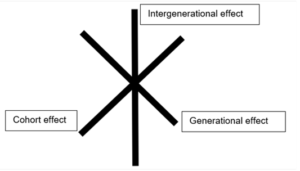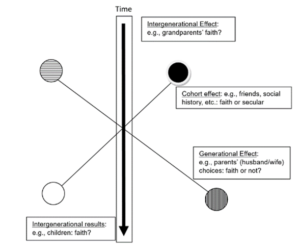I have searched for a simple way to explain three major sources of effect sizes in research. It is used with varying assignment of vectors or lines of influence, in everything from astronomy to drug testing.
The most likely you are to have seen these three vectors is in Pew research. If you want a glance at the “behind-the-scenes methodology of Pew Research Center see Lau & Kennedy (Assessing the effects of generation using age-period-cohort analysis, 2023). Since I’m not a mathematician, the Pew statistical formula are complex enough that they mostly give me a headache! However, the result is that Pew’s proprietary statistical formula elegantly separate out the three fundamental vectors of intergenerational, generational, and cohort effects.
The center post of the jack is an image for the intergenerational effect or vector Roberto (Lifelong Faith: Formaton for All Ages and Generations, 2022) has written about. It is central. We might make the case that the Church exists to pass on the faith.
(Lifelong Faith: Formaton for All Ages and Generations, 2022) has written about. It is central. We might make the case that the Church exists to pass on the faith.
As for the other pieces, one of the cross pieces images the generational effect or vector, in Christian anthropology that is the family. There is a vast amount of research, for example, on family or couple psychotherapy.
The other cross piece images the cohort effect or vector, namely, our year of birth. An example of this type of research is Pritchett’s (Friends for Life, Friends for Death: Cohorts and Consciousnes Among the Lunda-Ndembu, 2007) anthropological study.
Please try spinning your jack on a flat surface. The point is that like social systems, the jack can only spin if the vectors are balanced. Note too, that you can spin the jack on any of the three vectors if the jack is proportionally constructed. For that to happen each axis must be at 900 angles to the others.
There is a lot of research that is structured around the effects sizes of intergenerational, generational, and cohort effects that define the three vectors according to the variables of their science, e.g., astronomy, medicine, sociology, or anthropology.
 For example, in “…education research studies that compare different educational interventions, effect size is the magnitude of the difference between groups (NIH online dictionary).
For example, in “…education research studies that compare different educational interventions, effect size is the magnitude of the difference between groups (NIH online dictionary).
The absolute effect size is the difference between the average, or mean, outcomes in two different intervention groups. Sullivan & Fein (Barriers to Leading Small Groups among Generations Z and Younger Millennials: An Exploratory Factor Analysis and Implicaitons for Recruitment and Training, 2012).
A vector is “a quantity having direction as well as magnitude, especially as determining the position of one point in space relative to another” (Oxford Languages Online Dictionary).
Note, that mathematically an infinite number of vectors, or influences can be considered, but we humans typically use the triad model. Namely, we humans can admit that neither humans nor created reality are simple, but we humans can only deal with about three things at a time!
Cohort effects are variations over time, in one or more characteristics, among groups of individuals defined by some shared experience such as year or decade of birth, or years of a specific exposure. (Handbook of Clinical Neurology, 2016, p. ii, https://www.sciencedirect.com). For example, cohort effects can be used to study the risk of health outcomes based on year of birth, which can be related to changes in population exposure to risk factors over time.
Generational effect in social science or survey research describes how a cohort of people born at a certain time are different from another cohort of people born at a different time: so, for example, how a millennial behaves at age 25, compared to how previous generations—gen x-ers or boomers—behaved at age 25. (Online AI overview of psychosocial research). However, in Christian anthropology this term is interchangeable with families in that families are distinct from other families, for example, in their psychological, social, and biological experiences (Biersbach R. , Sex, Gender, Fantasy, and Desire, 2023).
Intergenerational effects sizes use a research perspective that, for example, examines how interventions that change parental income or education and that can impact their children’s outcomes. This research is concerned with causal relationships, rather than the descriptive associations that intergenerational mobility research focuses on (Online AI overview of research in medical, social, anthropological, and other fields).
For people of faith intergenerational effects are measured in terms of passing on faith from one generation to another.
In psychology, this term has been narrowly reduced to applications of trauma. Namely, the American Psychological Association (APA) defines it intergenerational effects as “a phenomenon in which the descendants of a person who has experienced a terrifying event show adverse emotional and behavioral reactions to the event that are similar to those of the person himself or herself.” Other terms for intergenerational trauma include: historical trauma, multigenerational trauma, and secondary traumatization. This narrow focus is the result of findings that trauma’s negative effects outweigh most efforts at causing positive effects intergenerationally.
Knowing what vector is under consideration is important because research methods vary significantly for each vector. For example,
- Intergenerational vectors are measured by survey methods such as the general reflections on a sample as seen in Pew Research. The individual in this vector is assessed a member of a large social group. For Catholics, this vector has often been focused on Mass attendance which in line with the Catechism section on sacraments, but with the decline in church attendance might be conceived as for those who become witnesses, the dependent variable in each of the Gospels in line with the Catechism section on the communion of saints.
- Generational vectors are measured by family systems methods. The individual in this vector is assessed as a member of a living bonded group of family or coupling. Outcomes research in this area is limited because so many variables are typically all going on at once. However, supporting parent training or increasing the number of people who marry in the church might be approaches to influence families.
- Cohort vectors are measured according to the focus of the type of experience that draws individual together. The individual here is someone sharing similar experiences with others, such as fellow employees in an employee work group, or small faith groups, or friendship social groups. A dependent variable here might be forming friendship mediated growth group participation or the ascent to God as in the SSA (Spiritual Self-Assessment).
Deacon Ray Biersbach, PhD
March 25, 2025

